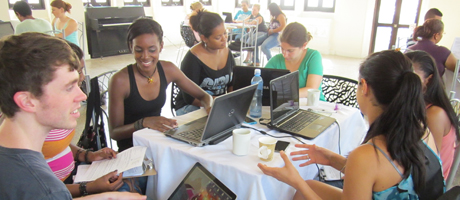George Washington student Joseph Duffey recently found himself embedded in the local culture of Panama City, entrenched in the politics and unique dynamics of the district of Casco Viejo, the historic UNESCO World Heritage Site in the throes of a massive renovation to rejuvenate the city as a tourist destination.
“We challenged ourselves to really learn about what life is like in that area and how people interact, work and spend their leisure time in such a historic area, both being challenged and growing as a result of infrastructural changes happening throughout the neighborhood,” said Mr. Duffey, a rising senior and geography major.
Mr. Duffey and eight other GW undergraduate and graduate students went on the two-week study abroad trip as part of the course “Urban Sustainability and Development: Summer Field Course in Panama” led by Professor of Geography and International Affairs Marie Price and Patricia Solís, an adjunct professor of geography and director of outreach and strategic initiatives for the Association of American Geographers.
The students’ charge was to research—something Dr. Price made clear from the beginning.
She told the students what to expect of their time in the field: “You’re really going to be working while you’re there.”
And work they did. In groups with Panamanian students, the students surveyed locals, asking them to detail the positives and negatives of their community, their satisfaction with public services like transportation and electricity and what most needed to be improved. They also completed a “reflective mapping” exercise, walking the city and noting the abundance of construction, how various areas were used and the overall sustainability.
The data made for a compelling culminating project in which the students presented their initial findings to various stakeholders involved in the Casco Viejo renovation, including city leaders and architects.
“It was a very proud moment as an educator to have a group of students that really pulled together and had a meaningful research experience,” Dr. Price said.
Dr. Solís agreed, adding she was impressed the group was so cooperative, open, and hungry to learn and contribute. “They were just really into it,” she said.
Back home, students are now working on research papers—ranging from urban sustainability to the impact of tourism—that they will submit to journals for publication.
As with study on campus, the time wasn’t all work. The group took a weekend off and headed to the remote San Blas Islands off the Caribbean coast, where they stayed at a lodge run by the indigenous Kuna Indians and toured the small yucca and plantain farms. The “beautiful tropical paradise” was a highlight, Mr. Duffey said.
Still, the main takeaway was the research. Mr. Duffey said the experience made him more interested in geography field work. And that’s exactly what Dr. Solís would want to hear. Work abroad, she said, has a way of making a lasting impact on a person’s career.
Interacting and collaborating with a new culture was also key.
“We really wanted to have this be a research experience and one that really had meaningful collaboration with Panamanian students,” Dr. Price said.
The students did just that: By the end, the U.S. and Panamanian students were friending each other on Facebook.


